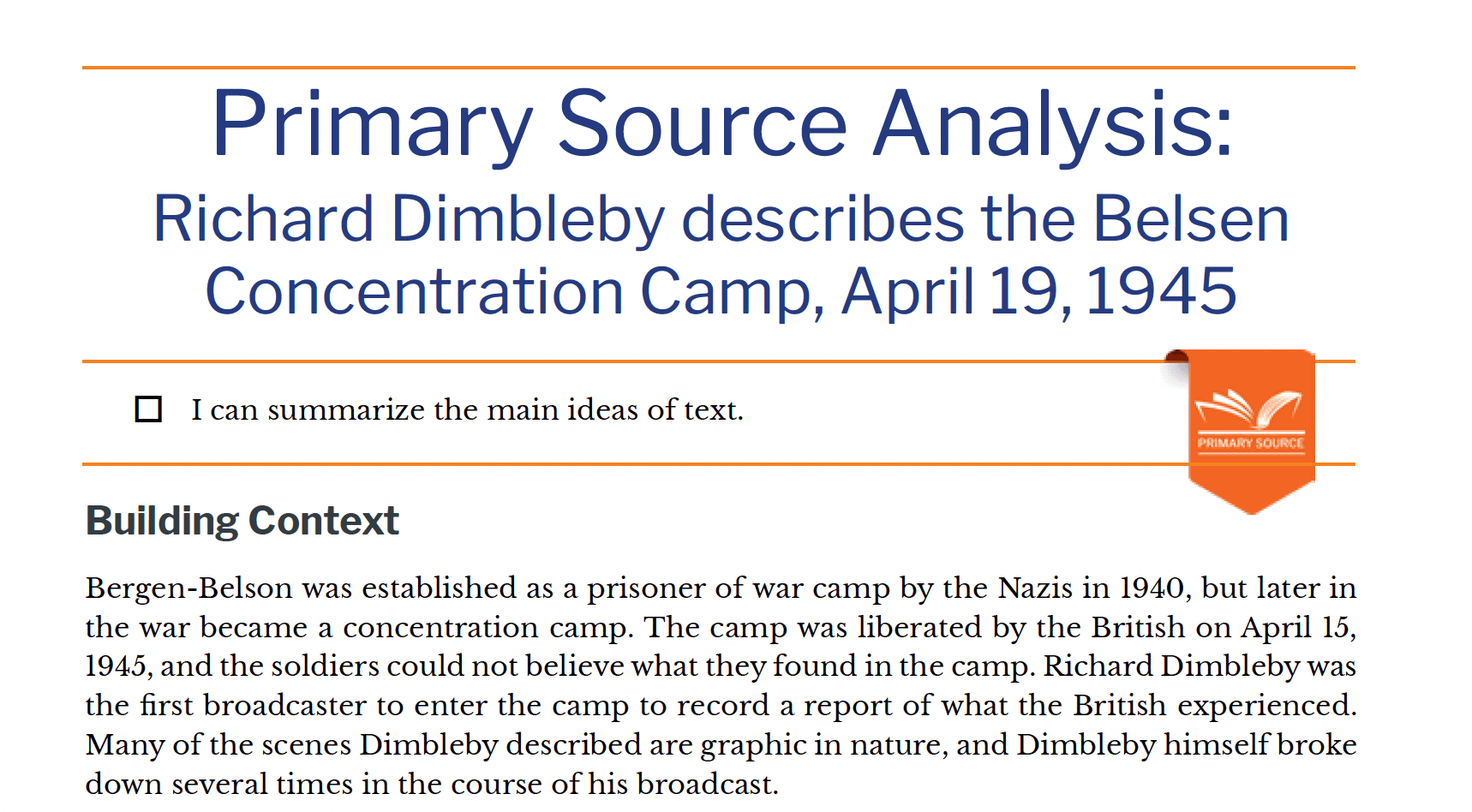Irma Grese and Self Deception Primary Source Analysis
- I can summarize the main ideas of text.
| Building Context |
Bergen-Belson was established as a prisoner of war camp by the Nazis in 1940, but later in the war became a concentration camp. The camp was liberated by the British on April 15, 1945, and the soldiers could not believe what they found in the camp. Richard Dimbleby was the first broadcaster to enter the camp to record a report of what the British experienced. Many of the scenes Dimbleby described are graphic in nature, and Dimbleby himself broke down several times in the course of his broadcast.
Source Link: https://bit.ly/43qXEi4
Primary Souce Text
| Notes | |
| I find it hard to describe adequately the horrible things that I’ve seen and heard but here unadorned are the facts. | |
| There are 40,000 men, women and children in the camp, German and half a dozen other nationalities and thousands of them Jews. | |
| Of this total of forty thousand, four thousand two hundred and fifty are acutely ill or dying of virulent disease. | |
| Typhus, typhoid, diphtheria, dysentery, pneumonia and childbirth fever are rife | |
| 25,600, three quarters of them women, are either ill from lack of food or are actually dying of starvation. | |
| In the last few months alone thirty thousand prisoners have been killed off or allowed to die.
Those are the simple horrible facts of Belsen.
But horrible as they are they can convey little or nothing in themselves. |
|
| ….
Dead bodies, some of them in decay lay strewn about the road. And along the rutted tracks on each side of the road were brown wooden huts. There were faces at the windows. The bony emaciated faces of starving women too weak to come outside – propping themselves against the glass to see the daylight before they died. …. |
|
| In the shade of some trees lay a great collection of bodies. I walked round them trying to count. There were perhaps a hundred and fifty flung down on each other – all naked, all so thin that their yellow skins glistened like stretched rubber on their bones.
Some of the poor starved creatures whose bodies were there looked so utterly unreal and inhuman that I could have imagined that they had never lived at all… |
|
| ….
We were on our way down to the crematorium where the Germans had burned alive thousands of men and women in a single fire. The furnace was in a hut about the size of a single garage – and the hut was surrounded by a small stockade… |
Debrief Questions:
- Who was Richard Dimbleby? Summarize Dimbleby’s experience at the camp.
- Why do you think he shared his experience at the camp with the radio audience?
Background Information
The picture you just analyzed is believed to show shipyard worker August Landmesser (1910 –1944) refusing to perform the Nazi salute at the launch of a naval training vessel in June 1936 in Hamburg, Germany. Landmesser joined the Nazi Party in 1931 but was expelled in 1935 and served jail time for his crime of Rassenschande (dishonoring the race) when he married a Jewish woman. He was later drafted to serve in World War II after being released, and was killed in action in 1944. His wife was taken by the Gestapo (Nazi political police) and sent to three different concentration camps. She is believed to have been killed at the Bernburg Euthanasia Center. The Landmessers’ two children survived the war.
Analysis Questions
- In the photograph, what are most of the people doing? From this photograph, what might we infer about which of these people we may actually be most like?
- When most of us look back at this period in history and at this picture, with whom are we more likely to identify — the people performing the Nazi salute or the individual refusing to salute?
- Have you ever personally witnessed someone standing up for what they knew to be right when no one else was doing so?
- Have you ever stood up for what you knew to be right when you could not see anyone else doing so?
- Thinking of one or both of the questions above, describe the courage this requires.
- Why is the virtue of courage especially important for citizens living in a society built on democratic principles?

